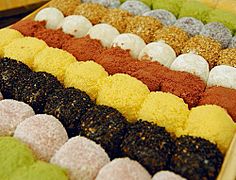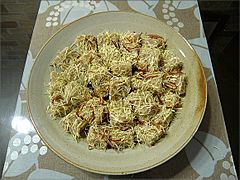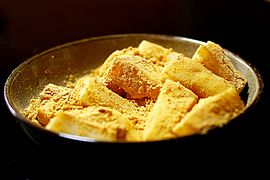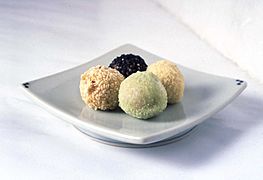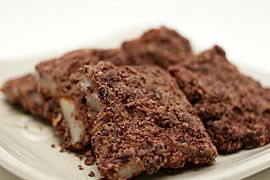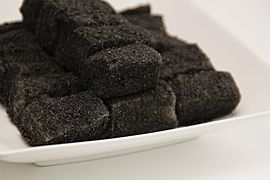Gomul facts for kids
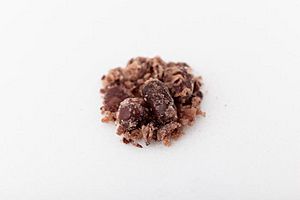
Pat-gomul (adzuki bean powder)
|
|
| Alternative names | Dressing powder |
|---|---|
| Place of origin | Korea |
| Associated national cuisine | Korean cuisine |
| Korean name | |
| Hangul |
고물
|
|---|---|
| Revised Romanization | kokot |
| McCune–Reischauer | komul |
| IPA | [ko.mul] |
Gomul (고물) is a special kind of powder or topping used in Korean cuisine. Think of it like sprinkles or a tasty coating! It can be a powder, a topping, a filling, or even a dip.
What is Gomul?
Gomul is made from different ingredients. It adds both flavor and a nice look to many Korean dishes. It makes food more interesting to eat.
How is Gomul Used?
Gomul is often used with tteok, which are Korean rice cakes. It makes them look better and taste even yummier! Some popular rice cakes that use gomul are injeolmi, danja, and gyeongdan.
Gomul is also used as a filling between layers of siru-tteok. This is a type of steamed rice cake. The gomul helps the steam move through the cake easily. This makes sure the rice cake cooks evenly.
You might also find gomul on top of bingsu. Bingsu is a delicious Korean shaved ice dessert. Sometimes, a special soybean gomul is served with grilled pork belly, called samgyeopsal. You can dip the meat into the powder before you eat it!
Different Kinds of Gomul
There are many types of gomul, each with its own flavor and color. Some are better for different seasons. For example, red bean or mung bean gomul is often used in winter. Soybean or sesame gomul is popular in summer because it doesn't spoil as quickly.
Here are some common types of gomul and how they are made:
Chestnut Gomul (Bam-gomul)
Bam-gomul (밤고물) is made from chestnuts. They are shelled and sliced into thin pieces or flakes. Sometimes, chestnuts are cooked, mashed, and then sieved to make a powder.
Jujube Gomul (Daechu-gomul)
Daechu-gomul (대추고물) uses jujubes, which are a type of sweet fruit. The skin of the jujube is peeled off and cut into thin strands or flakes.
Cowpea Gomul (Dongbu-gomul)
Dongbu-gomul (동부고물) is a white gomul made from cowpeas.
Hulled Red Bean Gomul (Geopipat-gomul)
This white gomul is made from red beans. The beans are ground, soaked in warm water, and then husked (their outer skin is removed). After that, they are steamed. Once cooked, they are salted, mashed, and sieved. Finally, they are pan-fried without oil over low heat.
Sesame Gomul (Kkae-gomul)
Kkae-gomul (깨고물) is made from sesame seeds. The seeds are washed, husked, and pan-fried without oil. They can be used whole or crushed into a coarse powder.
Black Sesame Gomul (Heugimja-gomul)
Heugimja-gomul (흑임자고물) is made from black sesame seeds. It's prepared in the same way as regular sesame gomul.
Soybean Gomul (Kong-gomul)
Kong-gomul (콩고물) is a yellow gomul made from soybeans. The soybeans are washed, drained, and roasted. Then, they are mashed with a little ginger, garlic, and salt. It's sieved to make it as fine or coarse as needed. Coarse kong-gomul is often used to coat injeolmi.
Mung Bean Gomul (Nokdu-gomul)
Nokdu-gomul (녹두고물) is a pale yellow gomul made from mung beans. It's made in a similar way to geopipat-gomul.
Red Bean Gomul (Pat-gomul)
Pat-gomul (팥고물) is a dark red gomul. It's made from unhusked red beans. The beans are boiled, drained, and then steamed for a long time. Once cooked, they are salted and mashed.
Rock Tripe Gomul (Seogi-gomul)
Seogi-gomul (석이고물) is made from rock tripe, which is a type of edible lichen. It's sliced into thin strands or flakes.
Gallery
-
Gyeongdan coated with various gomul
-
Danja coated with bam-daechu-gomul (chestnut and jujube strands)
-
Injeolmi coated with kong-gomul (soybean powder)
-
Gyeongdan coated with gomul
-
Siru-tteok filled with pat-gomul (red bean powder)
-
Injeolmi coated with heugimja-gomul (black sesame powder)
-
Gyeongdan coated with various gomul
-
Bingsu topped with kong-gomul (soybean powder)
-
Yeot coated with kong-gomul (soybean powder)
-
Kong-gomul (soybean powder) for dipping samgyeopsal (pork belly)


